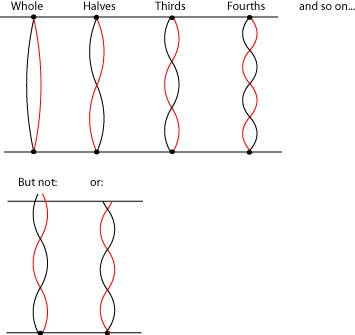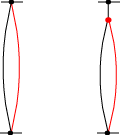| << Chapter < Page | Chapter >> Page > |
One "container" that works very well to produce standing waves is a thin, very taut string that is held tightly in place at both ends. Since the string is taut, it vibrates quickly, producing sound waves, if you pluck it, or rub it with a bow. Since it is held tightly at both ends, that means there has to be a node at each end of the string. Instruments that produce sound using strings are called chordophones , or simply strings .

The fundamental wave is the one that gives a string its pitch . But the string is making all those other possible vibrations, too, all at the same time, so that the actual vibration of the string is pretty complex. The other vibrations (the ones that basically divide the string into halves, thirds and so on) produce a whole series of harmonics . We don't hear the harmonics as separate notes, but we do hear them. They are what gives the string its rich, musical, string-like sound - its timbre . (The sound of a single frequency alone is a much more mechanical, uninteresting, and unmusical sound.) To find out more about harmonics and how they affect a musical sound, see Harmonic Series .

The string disturbs the air molecules around it as it vibrates, producing sound waves in the air. But another great container for standing waves actually holds standing waves of air inside a long, narrow tube. This type of instrument is called an aerophone , and the most well-known of this type of instrument are often called wind instruments because, although the instrument itself does vibrate a little, most of the sound is produced by standing waves in the column of air inside the instrument.
If it is possible, have a reed player and a brass player demonstrate to you the sounds that their mouthpieces make without the instrument. This will be a much "noisier" sound, with lots of extra frequencies in it that don't sound very musical. But, when you put the mouthpiece on an instrument shaped like a tube, only some of the sounds the mouthpiece makes are the right length for the tube. Because of feedback from the instrument, the only sound waves that the mouthpiece can produce now are the ones that are just the right length to become standing waves in the instrument, and the "noise" is refined into a musical tone.

Notification Switch
Would you like to follow the 'Sound, physics and music' conversation and receive update notifications?